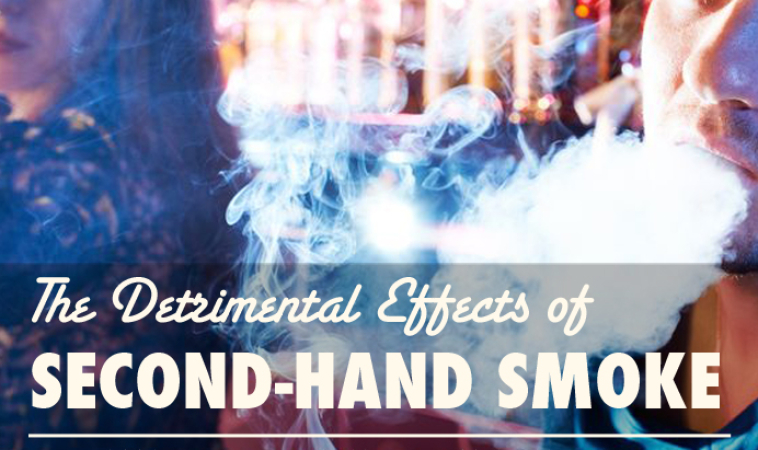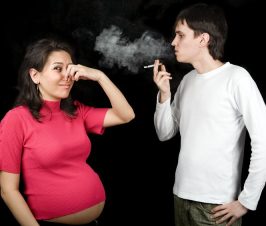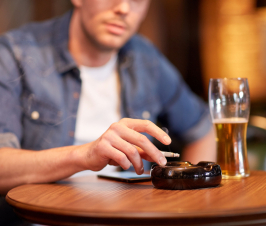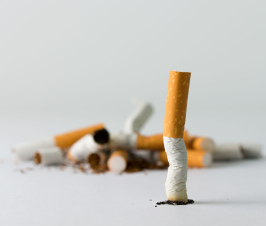Assisted by Naturopathic Medical Graduates Emily Rotella, Maria Wong, Natalia Ytsma, and Sara Mohammed
The Damage
It has been reported that “more than 800 Canadians die every year due to second-hand smoke (SHS) exposure”.1 SHS, also known as passive smoking has a dangerous effect on our health. It includes the smoke that escapes from “burning tobacco products, such as cigarettes, cigars, or pipes”, as well as what the smoker breathes out.2 Most exposure to SHS occurs in homes, workplaces, and public areas such as outside restaurants, in the parking lots of shopping centres, in the streets etc.2 The residues of the smoke can also remain in a person’s hair and clothing, as well as in carpets and furniture.2,3
There is no safe level of SHS exposure, since non-smokers take in nicotine and other toxic chemicals through the same route as smokers.4It has been reported that SHS contains over 4000 chemicals, and more than 70 chemicals are linked with causing cancer.1 SHS has been identified as a carcinogen by the International Agency for Research on Cancer and it has been estimated that living with a smoker increases the chance of getting lung cancer by 20% to 30%.4 Furthermore, exposure to SHS for as little as 8 to 20 minutes can increase the heart rate, decrease the amount of oxygen supplied to the heart, and constrict blood vessels leading to increased blood pressure, all of which are linked to heart disease and stroke.5
Everyone should avoid SHS, especially children, pregnant women, the elderly, and those with heart and lung conditions.1 Some of the harmful effects of SHS exposure include an increased risk of developing lung, laryngeal and pharyngeal cancer, severe dementia syndromes stroke, heart attacks, heart disease, lung disease (e.g. pneumonia and bronchitis), and possibly breast cancer.1,2,5 SHS can also irritate the skin, eyes, nose, and throat, cause congestion, sneezing, shortness of breath, coughing, and can worsen allergies and asthma.1,4
Pregnant Women and Children
With regards to pregnant women, non-smokers have healthier pregnancies, easier labours and faster recovery times post birth compared to smokers.1 SHS increases the chance of miscarriages, stillborn births, low-birth weight babies and other pregnancy and/or delivery problems.4 SHS exposure during pregnancy also increases the chance of a woman becoming depressed while she is pregnant.4 The toxic compounds in SHS can also pass through the placenta as well as the breast milk.1 Additionally, it has been reported that the toxic chemicals in tobacco smoke can possibly damage sperm and contribute to infertility.4
SHS is also very dangerous to a babies and child’s health. Babies breathe faster than adults and therefore inhale more smoke.5 Also, the lungs of babies and children are not fully developed and therefore can be more easily damaged by SHS.5 Children whom are exposed to SHS are more likely to struggle from coughing and wheezing, painful ear infections, asthma and other breathing problems, bronchitis, croup, pneumonia and sudden infant death syndrome (SIDS).1 Children exposed to SHS are also at an increased risk of developing, lymphoma, leukemia, and brain tumours, and are more likely to develop lung cancer as adults.4 Furthermore, children that are exposed to SHS do less well in school compared to those that are not.1
What to do about it
The best measures to avoid the harmful effects of SHS include avoiding smoking completely. If family members and friends are smokers they can be instructed to smoke outside the house in a far distance. Also, avoid smoking in the car since the chemicals from the smoke remain in the furniture of the car.3 If you live in “an apartment or condominium, installing special seals with foam insulation in electrical outlets, as well as sealing the cracks around vents and windows” may be helpful to avoid the smoke from entering.1 Further, while travelling you can request non-smoking flights and hotel rooms.3 Enforcing these rules is very important since no amount of SHS exposure is safe, and the effects of exposure can be very detrimental to everyone’s health.
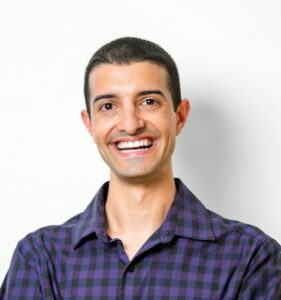
Chris Habib, BSc, ND, is an evidence-based naturopathic doctor with over a decade of education in healthcare. He is the clinic director of the multi-disciplinary clinic Mahaya Forest Hill and the Sales Director of the herbal company Perfect Herbs. Chris is also involved in teaching, research, and publishing. He is a clinic supervisor at the naturopathic college and teaches the board exam preparation course. He is also Associate Editor for the Journal of Restorative Medicine and Naturopathic Currents Magazine.
References:
- Canadian Cancer Society. Second-hand Smoke [Web Page]. Canadian Cancer Society Website. http://www.cancer.ca/en/cancer-information/cancer-101/what-is-a-risk-factor/tobacco/second-hand-smoke/?region=on. Accessed April 24, 2015.
- Centres for Disease Control and Prevention. Secondhand Smoke (SHS) Facts [Web Page]. Centres for Disease Control and Prevention Website. http://www.cdc.gov/tobacco/data_statistics/fact_sheets/secondhand_smoke/general_facts/. Accessed April 23, 2015.
- Mayoclinic. Secondhand Smoke: Avoid Dangers in the Air [Web Page]. Mayo Foundation for Medical Education and Research Website. http://www.mayoclinic.org/healthy-lifestyle/adult-health/in-depth/secondhand-smoke/art-20043914?pg=1. Accessed April 24, 2015.
- American Cancer Society. Secondhand Smoke [Web Page]. American Cancer Society Website. http://www.cancer.org/cancer/cancercauses/tobaccocancer/secondhand-smoke. Accessed April 23, 2015.
- Healthlink BC. The Harmful Effects of Second Hand Smoke [Web Page]. Healthlink BC Website. http://www.healthlinkbc.ca/healthfiles/hfile30a.stm. Accessed April 23, 2015.

